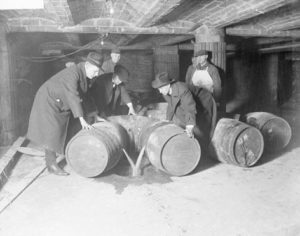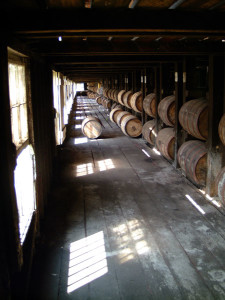By Richard Thomas
For the last few years, a popular factoid in My Old Kentucky Home is that we have more bourbon barrels socked away than people. With a population just shy of 4 1/2 million, crossing that threshold was a noteworthy milestone in the ongoing Bourbon Boom, but it pales in comparison to the one achieved in 2017. According to the statistics from the state Department of Revenue, which collects taxes on every single maturing barrel of spirits in storage in the state, the Commonwealth’s store of bourbon reached 7.5 million barrels, more than at any time since 1972.
Also, the number of barrels added to the inventory in 2017 crossed the 1.7 million mark for only the second time since 1968. Bourbon production in the state has finally reached approximately the same level it held prior to the worldwide whiskey bust of the 1970s, when changing tastes left distillers in not just Kentucky, but also Ireland and Scotland holding an ocean of whiskey few wanted to buy.
Yet it’s worth remembering the world was a smaller place in the early 1970s. America’s population was a third less than it is today, which is a useful yardstick for these things as, then and now, the United States remains the world’s most lucrative market for whiskey. Logically, it follows that the number of barrels in storage would need to grow to 10 million and the production to replace barrels dumped to 2.25 million before the taste for whiskey comes to equal its relative, former place.
How Far Can The Boom Go?
Kentucky alone hosted 157 distilleries before Prohibition. Today there are 73 in operation, of which about a dozen are engaged in making spirits other than whiskey. While I don’t believe any of those past distilleries were as big as the main plants of today’s “Kentucky Majors,” I’ve seen some pre-Prohibition ruins that are of comparable scale to today’s medium-sized distilleries. Even in terms of physical plant, Kentucky could enjoy some further growth and only just reach something similar to the scale of the whiskey industry it once had.
Knowing all of this points to three basic scenarios for where Kentucky Bourbon, as well as American Whiskey more broadly, is headed. My speculations focus on American tastes, because although exports were an increasingly important part of the business until President Trump’s incipient trade war (whiskey is one of the items that has seen widespread retaliatory tariffs imposed on it), the United States is where most of the customers are.
- Whiskey doesn’t resume its former place in American culture, and the plateau of growth may have already been reached. In that case, we can expect at least a hiccup in sales in the near future, followed by a general leveling off. I believe in the leveling off scenario because cultural matters like what people broadly tend to drink come and go with generations, and whiskey is popular with both Gen Xers and Millennials. If a 21st Century whiskey crash is coming, it will be coming with the generation behind the Millennials. Sales would fluctuate within a reasonable band, neither exploding or cratering, for at least a decade after that. Several years from now, the inventory of aged whiskey stocks would begin to expand again, as most production plans currently in place are based on a rosier scenario than this one.
- Whiskey resumes its relative place in American drinking culture, comparable to what it was in the 1960s. That scenario assumes plenty of growth, including another few years or more of explosive growth. Yet inevitably the boom must slow down, stop and level off as described above.
- Perhaps the future for the industry is brighter than the past, and whiskey’s popularity actually comes tp substantially outstrip what we’ve known since Prohibition. In that case, the business is bright for everyone currently in it, but perhaps not so bright for us imbibers. Long term explosive growth will put yet more pressure on stocks of aging whiskey, instead of that pressure decreasing or holding steady. More age statements will disappear, while premium and super-premium expressions will become scarcer and more expensive, as American Whiskey comes to fully resemble Scotch Whisky in terms of availability and pricing.
So keep an eye on how many barrels of whiskey are resting in Kentucky. If you see an article announcing there are three barrels for every person in the state in the near future, then it’s a good bet my #3 scenario is in the offing.
 The Whiskey Reviewer A World of Whiskey, Poured Every Weekday
The Whiskey Reviewer A World of Whiskey, Poured Every Weekday


